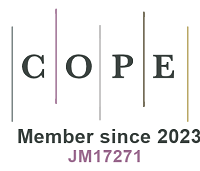REFERENCES
1. Peng J, Wang J, Cai L. Current understanding of microplastics in the environment: occurrence, fate, risks, and what we should do. Integr Environ Assess Manag 2017;13:476-82.
3. Carpenter EJ, Anderson SJ, Harvey GR, Miklas HP, Peck BB. Polystyrene spherules in coastal waters. Science 1972;178:749-50.
4. Gregory MR. Accumulation and distribution of virgin plastic granules on New Zealand beaches. N Z J Mar Freshwater Res 1978;12:399-414.
5. Gregory MR. Virgin plastic granules on some beaches of Eastern Canada and Bermuda. Mar Environ Res 1983;10:73-92.
6. Winston JE. Drift plastic - an expanding niche for a marine invertebrate? Mar Pollut Bull 1982;13:348-51.
7. Cheng L. Marine insects. 1976. Available from: https://escholarship.org/uc/item/1pm1485b. [Last accessed on 29 Nov 2023].
8. Barboza LGA, Dick Vethaak A, Lavorante BRBO, Lundebye AK, Guilhermino L. Marine microplastic debris: an emerging issue for food security, food safety and human health. Mar Pollut Bull 2018;133:336-48.
9. Dodhia MS, Rogers KL, Fernández-juárez V, et al. Microbe-mineral interactions in the Plastisphere: coastal biogeochemistry and consequences for degradation of plastics. Front Mar Sci 2023;10:1134815.
10. Cheng MLH, Lippmann TC, Dijkstra JA, et al. A baseline for microplastic particle occurrence and distribution in Great Bay Estuary. Mar Pollut Bull 2021;170:112653.
11. Seeley ME, Song B, Passie R, Hale RC. Microplastics affect sedimentary microbial communities and nitrogen cycling. Nat Commun 2020;11:2372.
12. Li J, Huang W, Xu Y, Jin A, Zhang D, Zhang C. Microplastics in sediment cores as indicators of temporal trends in microplastic pollution in Andong salt marsh, Hangzhou Bay, China. Reg Stud Mar Scie 2020;35:101149.
13. Lloret J, Pedrosa-Pamies R, Vandal N, et al. Salt marsh sediment act as sinks for microplastics and reveal effects of current and historical land use changes. Environ Adv 2021;4:100060.
14. Carson HS, Nerheim MS, Carroll KA, Eriksen M. The plastic-associated microorganisms of the North Pacific Gyre. Mar Pollut Bull 2013;75:126-32.
15. Jokiel PL. Long-distance dispersal by rafting: reemergence of an old hypothesis. Endeavour 1990;14:66-73.
17. Zettler ER, Mincer TJ, Amaral-Zettler LA. Life in the “plastisphere”: microbial communities on plastic marine debris. Environ Sci Technol 2013;47:7137-46.
18. Barnes D, Fraser K. Rafting by five phyla on man-made flotsam in the Southern Ocean. Mar Ecol Prog Ser 2003;262:289-91.
19. Barnes DK. Natural and plastic flotsam stranding in the Indian Ocean. In: Davenport J, Davenport JL, editors. The effects of human transport on ecosystems: cars and planes, boats and trains. Dublin: Royal Irish Academy; 2004. p. 193-205. Available from: https://nora.nerc.ac.uk/id/eprint/16343/. [Last accessed on 29 Nov 2023].
20. Masó M, Garcés E, Pagès F, Camp J. Drifting plastic debris as a potential vector for dispersing Harmful Algal Bloom (HAB) species. Sci Mar 2003;67:107-11.
21. Reisser J, Shaw J, Hallegraeff G, et al. Millimeter-sized marine plastics: a new pelagic habitat for microorganisms and invertebrates. PLoS One 2014;9:e100289.
22. Thompson RC, Olsen Y, Mitchell RP, et al. Lost at sea: where is all the plastic? Science 2004;304:838.
23. Plastic rafting: the invasive species hitching, a ride on ocean litter. Available from: https://www.theguardian.com/environment/2021/jun/14/plastic-rafting-the-invasive-species-hitching-a-ride-on-ocean-litter. [Last accessed on 29 Nov 2023].
24. McCormick A, Hoellein TJ, Mason SA, Schluep J, Kelly JJ. Microplastic is an abundant and distinct microbial habitat in an urban river. Environ Sci Technol 2014;48:11863-71.
25. Urbanek AK, Rymowicz W, Mirończuk AM. Degradation of plastics and plastic-degrading bacteria in cold marine habitats. Appl Microbiol Biotechnol 2018;102:7669-78.
26. Rogers KL, Carreres-calabuig JA, Gorokhova E, Posth NR. Micro-by-micro interactions: how microorganisms influence the fate of marine microplastics. Limnol Oceanogr Lett 2020;5:18-36.
27. Gregory MR. Environmental implications of plastic debris in marine settings--entanglement, ingestion, smothering, hangers-on, hitch-hiking and alien invasions. Philos Trans R Soc Lond B Biol Sci 2009;364:2013-25.
28. Browne MA, Dissanayake A, Galloway TS, Lowe DM, Thompson RC. Ingested microscopic plastic translocates to the circulatory system of the mussel, mytilus edulis (L.). Environ Sci Technol 2008;42:5026-31.
29. Cole M, Lindeque P, Fileman E, Halsband C, Galloway TS. The impact of polystyrene microplastics on feeding, function and fecundity in the marine copepod calanus helgolandicus. Environ Sci Technol 2015;49:1130-7.
30. Al-Sid-Cheikh M, Rowland SJ, Stevenson K, Rouleau C, Henry TB, Thompson RC. Uptake, whole-body distribution, and depuration of nanoplastics by the scallop pecten maximus at environmentally realistic concentrations. Environ Sci Technol 2018;52:14480-6.
31. Watts AJ, Lewis C, Goodhead RM, et al. Uptake and retention of microplastics by the shore crab carcinus maenas. Environ Sci Technol 2014;48:8823-30.
32. Farthing J, Laing I, Dore WJ. Depuration conditions for great scallops (Pecten maximus). J Shellfish Res 2003;22:409-14. Available from: https://api.semanticscholar.org/CorpusID:82533626. [Last accessed on 29 Nov 2023]
33. Canniff PM, Hoang TC. Microplastic ingestion by Daphnia magna and its enhancement on algal growth. Sci Total Environ 2018;633:500-7.
34. Sussarellu R, Suquet M, Thomas Y, et al. Oyster reproduction is affected by exposure to polystyrene microplastics. Proc Natl Acad Sci U S A 2016;113:2430-5.
35. Markham E, Brault EK, Khairy M, et al. Time trends of polybrominated diphenyl ethers (PBDEs) in Antarctic biota. ACS Omega 2018;3:6595-604.
36. Dawson AL, Kawaguchi S, King CK, et al. Turning microplastics into nanoplastics through digestive fragmentation by Antarctic krill. Nat Commun 2018;9:1001.
37. Suckling CC. Responses to environmentally relevant microplastics are species-specific with dietary habit as a potential sensitivity indicator. Sci Total Environ 2021;751:142341.
38. Biamis C, Driscoll KO, Hardiman G. Microplastic toxicity: a review of the role of marine sentinel species in assessing the environmental and public health impacts. Case Stud Chem Environ Eng 2021;3:100073.
39. Smith M, Love DC, Rochman CM, Neff RA. Microplastics in seafood and the implications for human health. Curr Environ Health Rep 2018;5:375-86.
40. Dehaut A, Cassone AL, Frère L, et al. Microplastics in seafood: benchmark protocol for their extraction and characterization. Environ Pollut 2016;215:223-33.
41. Rochman CM, Tahir A, Williams SL, et al. Anthropogenic debris in seafood: Plastic debris and fibers from textiles in fish and bivalves sold for human consumption. Sci Rep 2015;5:14340.
42. Kroon FJ, Motti CE, Jensen LH, Berry KLE. Classification of marine microdebris: a review and case study on fish from the Great Barrier Reef, Australia. Sci Rep 2018;8:16422.
43. Laursen SN, Fruergaard M, Dodhia MS, et al. Settling of buoyant microplastic in estuaries: the importance of flocculation. Sci Total Environ 2023;886:163976.
44. Short FT. The ecology of the Great Bay Estuary, New Hampshire and Maine: an estuarine profile and bibliography. PREP Reports & Publications; 1992. p. 222. Available from: https://scholars.unh.edu/prep/376/. [Last accessed on 29 Nov 2023].
45. Stasse A, MLH Cheng, K Meyer, et al. Temporal dynamics of eastern oyster, larval abundance in Great Bay Estuary, New Hampshire. J Shellfish Res 2022;40:471-8.
46. Masura J, Baker J, Foster G, Arthur C. Laboratory methods for the analysis of microplastics in the marine environment: recommendations for quantifying synthetic particles in waters and sediments. Available from: https://repository.oceanbestpractices.org/handle/11329/1076. [Last accessed on 29 Nov 2023].
47. Hung C, Klasios N, Zhu X, Sedlak M, Sutton R, Rochman CM. Methods matter: methods for sampling microplastic and other anthropogenic particles and their implications for monitoring and ecological risk assessment. Integr Environ Assess Manag 2021;17:282-91.
48. Brander SM, Renick VC, Foley MM, et al. Sampling and quality assurance and quality control: a guide for scientists investigating the occurrence of microplastics across matrices. Appl Spectrosc 2020;74:1099-125.
49. Miller E, Sedlak M, Lin D, et al. Recommended best practices for collecting, analyzing, and reporting microplastics in environmental media: lessons learned from comprehensive monitoring of San Francisco Bay. J Hazard Mater 2021;409:124770.
50. Zhu X, Munno K, Grbic J, et al. Holistic assessment of microplastics and other anthropogenic microdebris in an urban bay sheds light on their sources and fate. ACS EST Water 2021;1:1401-10.
51. Pasquier G, Doyen P, Kazour M, et al. Manta net: the golden method for sampling surface water microplastics in aquatic environments. Front Environ Sci 2022;10:811112.
52. Payne AR, Burdick DM, Moore GE, Wigand C. Short-term effects of thin-layer sand placement on salt marsh grasses: a marsh organ field experiment. J Coast Res 2021;37:771-8.
53. Enders K, Lenz R, Beer S, Stedmon CA, Browman H. Extraction of microplastic from biota: recommended acidic digestion destroys common plastic polymers. ICES J Mar Sci 2017;74:326-31.
54. Maes T, Jessop R, Wellner N, Haupt K, Mayes AG. A rapid-screening approach to detect and quantify microplastics based on fluorescent tagging with Nile Red. Sci Rep 2017;7:44501.
55. Shim WJ, Song YK, Hong SH, Jang M. Identification and quantification of microplastics using Nile Red staining. Mar Pollut Bull 2016;113:469-76.
56. Erni-Cassola G, Gibson MI, Thompson RC, Christie-Oleza JA. Lost, but found with nile red: a novel method for detecting and quantifying small microplastics (1 mm to 20 μm) in environmental samples. Environ Sci Technol 2017;51:13641-8.
57. Prata JC, da Costa JP, Duarte AC, Rocha-santos T. Methods for sampling and detection of microplastics in water and sediment: a critical review. TrAC Trends Analyt Chem 2019;110:150-9.
58. Scircle A, Cizdziel JV, Tisinger L, Anumol T, Robey D. Occurrence of microplastic pollution at oyster reefs and other coastal sites in the Mississippi sound, USA: impacts of freshwater inflows from flooding. Toxics 2020;8:35.
59. Bäuerlein PS, Pieke EN, Oesterholt FIHM, Ter Laak T, Kools SAE. Microplastic discharge from a wastewater treatment plant: long term monitoring to compare two analytical techniques, LDIR and optical microscopy while also assessing the removal efficiency of a bubble curtain. Water Sci Technol 2023;87:39-56.
60. Nizamali J, Mintenig SM, Koelmans AA. Assessing microplastic characteristics in bottled drinking water and air deposition samples using laser direct infrared imaging. J Hazard Mater 2023;441:129942.
61. Whiting QT, O'Connor KF, Potter PM, Al-Abed SR. A high-throughput, automated technique for microplastics detection, quantification, and characterization in surface waters using laser direct infrared spectroscopy. Anal Bioanal Chem 2022;414:8353-64.
62. Coppock RL, Cole M, Lindeque PK, Queirós AM, Galloway TS. A small-scale, portable method for extracting microplastics from marine sediments. Environ Pollut 2017;230:829-37.
63. Stanton T, Johnson M, Nathanail P, Gomes RL, Needham T, Burson A. Exploring the efficacy of nile red in microplastic quantification: a costaining approach. Environ Sci Technol Lett 2019;6:606-11.
64. Brown WS, Arellano E. The application of a segmented tidal mixing model to the Great Bay Estuary, N. H. Estuaries 1980;3:248-57.
65. Neto JA, Gaylarde C, Beech I, Bastos AC, da Silva Quaresma V, de Carvalho DG. Microplastics and attached microorganisms in sediments of the Vitória bay estuarine system in SE Brazil. Ocean Coast Manag 2019;169:247-53.
66. McEachern K, Alegria H, Kalagher AL, Hansen C, Morrison S, Hastings D. Microplastics in Tampa Bay, Florida: abundance and variability in estuarine waters and sediments. Mar Pollut Bull 2019;148:97-106.
67. Song YK, Hong SH, Jang M, et al. A comparison of microscopic and spectroscopic identification methods for analysis of microplastics in environmental samples. Mar Pollut Bull 2015;93:202-9.
68. Barrows APW, Cathey SE, Petersen CW. Marine environment microfiber contamination: global patterns and the diversity of microparticle origins. Environ Pollut 2018;237:275-84.
69. Covernton GA, Pearce CM, Gurney-Smith HJ, et al. Size and shape matter: a preliminary analysis of microplastic sampling technique in seawater studies with implications for ecological risk assessment. Sci Total Environ 2019;667:124-32.
70. Cutroneo L, Reboa A, Besio G, et al. Microplastics in seawater: sampling strategies, laboratory methodologies, and identification techniques applied to port environment. Environ Sci Pollut Res Int 2020;27:8938-52.
71. Biltcliff-ward A, Stead JL, Hudson MD. The estuarine plastics budget: a conceptual model and meta-analysis of microplastic abundance in estuarine systems. Estuar Coast Shelf Sci 2022;275:107963.
72. Bikker J, Lawson J, Wilson S, Rochman CM. Microplastics and other anthropogenic particles in the surface waters of the Chesapeake Bay. Mar Pollut Bull 2020;156:111257.
73. Cohen JH, Internicola AM, Mason RA, Kukulka T. Observations and simulations of microplastic debris in a tide, wind, and freshwater-driven estuarine environment: the Delaware Bay. Environ Sci Technol 2019;53:14204-11.
74. Suresh A, Vijayaraghavan G, Saranya KS, Neethu KV, Aneesh B, Bijoy Nandan S. Microplastics distribution and contamination from the Cochin coastal zone, India. Reg Stud Mar Sci 2020;40:101533.
75. Zhao S, Zhu L, Wang T, Li D. Suspended microplastics in the surface water of the Yangtze Estuary System, China: first observations on occurrence, distribution. Mar Pollut Bull 2014;86:562-8.
76. Hitchcock JN, Mitrovic SM. Microplastic pollution in estuaries across a gradient of human impact. Environ Pollut 2019;247:457-66.
77. Ragoobur D, Amode NS, Somaroo GD, Nazurally N. Microplastics in estuarine water and sediment in Mauritius. Reg Stud Mar Sci 2023;57:102766.
78. Fulfer VM, Walsh JP. Extensive estuarine sedimentary storage of plastics from city to sea: Narragansett Bay, Rhode Island, USA. Sci Rep 2023;13:10195.
79. Claessens M, De Meester S, Van Landuyt L, De Clerck K, Janssen CR. Occurrence and distribution of microplastics in marine sediments along the Belgian coast. Mar Pollut Bull 2011;62:2199-204.
80. Cozzolino L, Nicastro KR, Zardi GI, de Los Santos CB. Species-specific plastic accumulation in the sediment and canopy of coastal vegetated habitats. Sci Total Environ 2020;723:138018.
81. Nor NH, Obbard JP. Microplastics in Singapore's coastal mangrove ecosystems. Mar Pollut Bull 2014;79:278-83.
82. Vianello A, Boldrin A, Guerriero P, et al. Microplastic particles in sediments of Lagoon of Venice, Italy: first observations on occurrence, spatial patterns and identification. Estuar Coast Shelf Sci 2013;130:54-61.
83. Liebezeit G, Dubaish F. Microplastics in beaches of the East Frisian islands Spiekeroog and Kachelotplate. Bull Environ Contam Toxicol 2012;89:213-7.
84. Lv L, Qu J, Yu Z, et al. A simple method for detecting and quantifying microplastics utilizing fluorescent dyes - Safranine T, fluorescein isophosphate, Nile red based on thermal expansion and contraction property. Environ Pollut 2019;255:113283.
85. Montoto-Martínez T, Meléndez-Díez C, Melián-Ramírez A, Hernández-Brito JJ, Gelado-Caballero MD. Comparison between the traditional Manta net and an innovative device for microplastic sampling in surface marine waters. Mar Pollut Bull 2022;185:114237.
86. Yonkos LT, Friedel EA, Perez-Reyes AC, Ghosal S, Arthur CD. Microplastics in four estuarine rivers in the Chesapeake Bay, U.S.A. Environ Sci Technol 2014;48:14195-202.
87. Lattin GL, Moore CJ, Zellers AF, Moore SL, Weisberg SB. A comparison of neustonic plastic and zooplankton at different depths near the southern California shore. Mar Pollut Bull 2004;49:291-4.
88. Moore CJ, Moore SL, Weisberg SB, Lattin GL, Zellers AF. A comparison of neustonic plastic and zooplankton abundance in southern California's coastal waters. Mar Pollut Bull 2002;44:1035-8.
89. Manickavasagam S, Kumar S, Kumar K, Rathi Bhuvaneswari G, Paul T, Shukla S. Quantitative assessment of influx and efflux of marine debris in a water channel of South Juhu creek, Mumbai, India. Reg Stud Mar Sci 2020;34:101095.
90. Sadri SS, Thompson RC. On the quantity and composition of floating plastic debris entering and leaving the Tamar Estuary, Southwest England. Mar Pollut Bull 2014;81:55-60.
91. Fok L, Cheung PK, Tang G, Li WC. Size distribution of stranded small plastic debris on the coast of Guangdong, South China. Environ Pollut 2017;220:407-12.
92. Bilgili A, Proehl JA, Lynch DR, Smith KW, Swift MR. Estuary/ocean exchange and tidal mixing in a Gulf of Maine Estuary: a Lagrangian modeling study. Estuar Coast Shelf Sci 2005;65:607-24.
93. Gallagher TW, Mancilla C. MEMORANDUM: calibration of Great Bay Estuary hydrodynamic model and incremental nitrogen estimation. Available from: https://scholars.unh.edu/prep/411/. [Last accessed on 29 Nov 2023].
94. Matso K. Flushing time versus residence time for the Great Bay Estuary. Available from: https://scholars.unh.edu/prep/413/. [Last accessed on 29 Nov 2023].
95. Seabrook station environmental report, vol.1 - construction permit. Available from: https://www.nrc.gov/docs/ML1028/ML102880614.html. [Last accessed on 29 Nov 2023].
96. Trowbridge P. Hydrological parameters for New Hampshire’s Estuaries. Available from: https://scholars.unh.edu/prep/130/. [Last accessed on 29 Nov 2023].
97. Eberhardt AL, Burdick DM. Hampton-seabrook estuary restoration compendium. Available from: https://scholars.unh.edu/prep/76/. [Last accessed on 29 Nov 2023].
98. Piscataqua Region Estuaries Partnership. Piscataqua region environmental planning assessment 2015. Available from: https://scholars.unh.edu/prep/358/. [Last accessed on 29 Nov 2023].
99. Payne AR, Burdick DM, Moore GE. Potential effects of sea-level rise on salt marsh elevation dynamics in a New Hampshire Estuary. Estuaries Coast 2019;42:1405-18.
100. Barnes DKA. Remote islands reveal rapid rise of southern hemisphere, sea debris. Sci World J 2005;5:915-21.
101. Browne MA, Crump P, Niven SJ, et al. Accumulation of microplastic on shorelines woldwide: sources and sinks. Environ Sci Technol 2011;45:9175-9.







